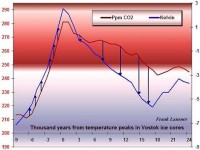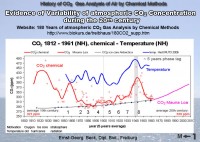By Maggie Koerth-Baker in National Geographic
What happens when carbon dioxide levels skyrocket? Most climate scientists think they know the answer: global warming.
But to determine just how high temperatures may climb and how climate patterns may shift, researchers may need to pinpoint, for comparison, a time in our planet’s past when a similar carbon dioxide jump happened.
“We really don’t know how high CO2 has been in the geologic past. Thus we don’t know how sensitive the surface temperature of the Earth is to CO2,” said Don DePaolo, head of the Earth Sciences Division at the Lawrence Berkley National Laboratory in California.
Most global warming predictions are based on fluctuations in CO2 levels and temperature that happened between a relatively recent series of ice ages, said DePaolo, who was not involved in the new study, which will appear in tomorrow’s issue of the journal Science.
Chemicals in ice cores, for example, can show how CO2 levels have changed over time, down to five-year intervals.
But ice core records only go back about 800,000 years. By studying chemicals in long-dead, single-celled plankton called foraminifera, though, the team behind the new study was able to extend the climate record back 2.1 million years (prehistoric time line). The method doesn’t provide as much detail, but it does give a pretty clear picture of what was going on at roughly thousand-year intervals.
Carbon dioxide, or CO2, is a naturally occurring greenhouse gas that is also released into the atmosphere by the burning of fossil fuels, for example in cars and power plants (causes of global warming).
“We really don’t know how high CO2 has been in the geologic past. Thus we don’t know how sensitive the surface temperature of the Earth is to CO2,” said Don DePaolo, head of the Earth Sciences Division at the Lawrence Berkley National Laboratory in California. Most global warming predictions are based on fluctuations in CO2 levels and temperature that happened between a relatively recent series of ice ages, said DePaolo, who was not involved in the new study, which will appear in tomorrow’s issue of the journal Science.
Chemicals in ice cores, for example, can show how CO2 levels have changed over time, down to five-year intervals. But ice core records only go back about 800,000 years. By studying chemicals in long-dead, single-celled plankton called foraminifera, though, the team behind the new study was able to extend the climate record back 2.1 million years (prehistoric time line). The method doesn’t provide as much detail, but it does give a pretty clear picture of what was going on at roughly thousand-year intervals. Read more here.
Icecap Notes: There is other evidence that CO2 is actually lower than most of historic times (larger image here).

and that it lagged behind the temperature (averaged over numerous Milankovitch cycles) not led the temperature as shown here.

See large image here
See also There is No Evidence by David Evans here, CO2 the Houdini of Gases by Alan Siddons here, and The Sun Heats the Earth by Hans Schreuder here and the True Levels of CO2? by Ernst George-Beck here in which hew shows actual chemical measurements suggest current levels may have been exceeded even in the last two centuries.

See large image here
As far as I am concerned the true facts as even hinted by the authors in the National Geographic are not well established and can offer little support for any ‘proof’ of CO2 is even a minor driver of climate change. There is no single paper that proves the connection from first principles. Only the coincidental rise of CO2 and temperatures from 1979 to 1998. All of this house of cards is based on the 19th century work of Arrhenius, who later in life, called in question his own early calculations and of course the failing climate models. This last week, Gavin Schmidt of Real Climate noted there would be fewer posts as they were scurrying around to put together a reasonably workable model for IPCC 2010 scenarios. Does that sound like they have the modeling perfected as they and other have claimed?
Along the same lines, Richard Mackey notes “Easterling, D R and Wehner, M P. “Is the climate warming or cooling” Geophysical Research Letters Vol 36 L08706, doi:10.1029/2009GL037810,2009, published 25 April 2009, the Abstract of which reads:
“Numerous websites, blogs and articles in the media have claimed that the climate is no longer warming, and is now cooling. Here we show that periods of no trend or even cooling ofthe globally averaged surface air temperature are found in the last 34 years of the observed record, and in climate model simulations of the 20th and 21st century forced with increasing greenhouse gases. We show that the climate over the 21st century can and likely will produce periods of a decade or two where the globally averaged surface air temperature shows no trend or even slight cooling in the presence of longer-term warming.” They also note “...cooling is a symptom of warming”.
The GCMs don’t predict the periodicities caused by the atmospheric/ oceanic oscillations like ENSO, PDO, IOD, NAO, etc. As the paper argues, if there is a long term upward trend, it can readily be compatible with these momentary mini-troughs of coolness. So the occurance of recent cooling or merely a ceasation of warming doesn’t mean much - if you are an IPCC groupie, even if it means the models aren’t very good.




